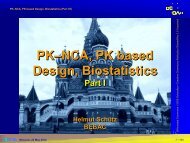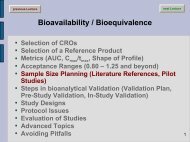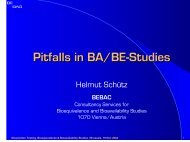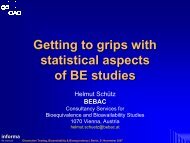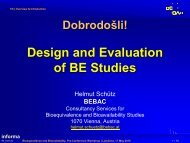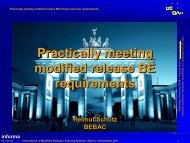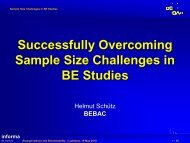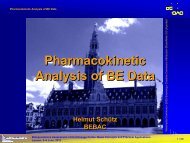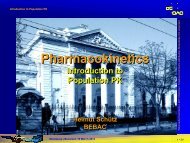Statistical Analysis of BE Data - BEBAC ⢠Consultancy Services for ...
Statistical Analysis of BE Data - BEBAC ⢠Consultancy Services for ...
Statistical Analysis of BE Data - BEBAC ⢠Consultancy Services for ...
You also want an ePaper? Increase the reach of your titles
YUMPU automatically turns print PDFs into web optimized ePapers that Google loves.
Wikimedia Commons • 2005 Snowdog • Creative Commons Attribution-ShareAlike<br />
3.0 Unported<br />
<strong>Statistical</strong> <strong>Analysis</strong> <strong>of</strong> <strong>BE</strong> <strong>Data</strong><br />
1• 83<br />
<strong>Statistical</strong> <strong>Analysis</strong><br />
<strong>of</strong> <strong>BE</strong> <strong>Data</strong><br />
Helmut Schütz<br />
<strong>BE</strong>BAC<br />
Bioequivalence Assessment <strong>of</strong> Oral Dosage Forms: Basic Concepts and Practical Applications<br />
Leuven, 5–6 June, 2013
<strong>Statistical</strong> <strong>Analysis</strong> <strong>of</strong> <strong>BE</strong> <strong>Data</strong><br />
Designs<br />
yes<br />
long half-life and/or<br />
patients with unstable<br />
conditions<br />
no<br />
no<br />
parallel design<br />
paired design<br />
cross-over design<br />
reliable in<strong>for</strong>mations<br />
about CV<br />
yes<br />
no<br />
>2 <strong>for</strong>mulations<br />
yes<br />
fixed sample design<br />
two-stage design<br />
CV >30<br />
multi-arm parallel<br />
higher-order cross-over<br />
yes<br />
no<br />
replicate design<br />
conventional cross-over design<br />
Bioequivalence Assessment <strong>of</strong> Oral Dosage Forms: Basic Concepts and Practical Applications<br />
Leuven, 5–6 June, 2013<br />
2• 83
<strong>Statistical</strong> <strong>Analysis</strong> <strong>of</strong> <strong>BE</strong> <strong>Data</strong><br />
Designs<br />
In<strong>for</strong>mation<br />
•The more ‘sophisticated’ a design is, the more<br />
in<strong>for</strong>mation can be extracted<br />
•Hierarchy <strong>of</strong> designs:<br />
Full replicate (TRTR | RTRT or TRT | RTR), <br />
Partial replicate (TRR | RTR | RRT) <br />
Standard 2×2 cross-over (RT | RT) <br />
Parallel (R | T)<br />
•Variances which can be estimated:<br />
Parallel: total variance (between + within)<br />
2×2 Xover: + between, within subjects <br />
Partial replicate: + within subjects (reference) <br />
Full replicate: + within subjects (reference, test) <br />
Bioequivalence Assessment <strong>of</strong> Oral Dosage Forms: Basic Concepts and Practical Applications<br />
Leuven, 5–6 June, 2013<br />
3• 83
<strong>Statistical</strong> <strong>Analysis</strong> <strong>of</strong> <strong>BE</strong> <strong>Data</strong><br />
<strong>Data</strong> Trans<strong>for</strong>mation<br />
•<strong>BE</strong> testing started in the early 1980s with an<br />
acceptance range <strong>of</strong> 80% – 120% <strong>of</strong> the<br />
reference based on the normal distribution<br />
•Was questioned in the mid 1980s<br />
•Like many biological variables AUC and C max do not<br />
follow a normal distribution<br />
• Negative values are impossible<br />
• The distribution is skewed to the right<br />
• Might follow a lognormal distribution<br />
•Serial dilutions in bioanalytics lead to multiplicative<br />
errors<br />
Bioequivalence Assessment <strong>of</strong> Oral Dosage Forms: Basic Concepts and Practical Applications<br />
Leuven, 5–6 June, 2013<br />
4• 83
<strong>Statistical</strong> <strong>Analysis</strong> <strong>of</strong> <strong>BE</strong> <strong>Data</strong><br />
Density<br />
Sample Quantiles<br />
0.000 0.005 0.010 0.015 0.020 0.025 0.030 0.035<br />
20 40 60 80 100 120<br />
<strong>Data</strong> Trans<strong>for</strong>mation<br />
MPH, 437 subjects<br />
0 50 100 150<br />
AUC [ng×h/mL]<br />
Shapiro-Wilk p= 1.3522e-14<br />
Normal Q-Q Plot<br />
Density<br />
Sample Quantiles<br />
0.0 0.2 0.4 0.6 0.8 1.0 1.2<br />
3.0 3.5 4.0 4.5<br />
MPH, 437 subjects<br />
2.5 3.0 3.5 4.0 4.5 5.0<br />
ln(AUC [ng×h/mL])<br />
Shapiro-Wilk p= 0.29343<br />
Normal Q-Q Plot<br />
Pooled data<br />
from real<br />
studies.<br />
Clearly in<br />
favor <strong>of</strong> a<br />
lognormal<br />
distribution.<br />
Shapiro-Wilk<br />
test highly<br />
significant <strong>for</strong><br />
normal distribution<br />
(assumption<br />
rejected).<br />
-3 -2 -1 0 1 2 3<br />
Theoretical Quantiles<br />
-3 -2 -1 0 1 2 3<br />
Theoretical Quantiles<br />
Bioequivalence Assessment <strong>of</strong> Oral Dosage Forms: Basic Concepts and Practical Applications<br />
Leuven, 5–6 June, 2013<br />
5• 83
<strong>Statistical</strong> <strong>Analysis</strong> <strong>of</strong> <strong>BE</strong> <strong>Data</strong><br />
<strong>Data</strong> Trans<strong>for</strong>mation!<br />
Density<br />
Sample Quantiles<br />
0.000 0.005 0.010 0.015 0.020 0.025 0.030 0.035<br />
20 30 40 50 60<br />
MPH, 12 subjects<br />
0 50 100 150<br />
AUC [ng×h/mL]<br />
Shapiro-Wilk p= 0.29667<br />
Normal Q-Q Plot<br />
Density<br />
Sample Quantiles<br />
0.0 0.5 1.0 1.5<br />
3.0 3.2 3.4 3.6 3.8 4.0<br />
MPH, 12 subjects<br />
2.5 3.0 3.5 4.0 4.5 5.0<br />
ln(AUC [ng×h/mL])<br />
Shapiro-Wilk p= 0.85764<br />
Normal Q-Q Plot<br />
<strong>Data</strong> <strong>of</strong> a real<br />
study.<br />
Both tests not<br />
significant<br />
(assumptions<br />
accepted).<br />
Tests not<br />
acceptable<br />
according to<br />
GLs.<br />
Trans<strong>for</strong>mation<br />
based on<br />
prior knowledge<br />
(PK)!<br />
-1.5 -1.0 -0.5 0.0 0.5 1.0 1.5<br />
Theoretical Quantiles<br />
-1.5 -1.0 -0.5 0.0 0.5 1.0 1.5<br />
Theoretical Quantiles<br />
Bioequivalence Assessment <strong>of</strong> Oral Dosage Forms: Basic Concepts and Practical Applications<br />
Leuven, 5–6 June, 2013<br />
6• 83
<strong>Statistical</strong> <strong>Analysis</strong> <strong>of</strong> <strong>BE</strong> <strong>Data</strong><br />
Parallel design<br />
•Two-Group Parallel Design<br />
Subjects<br />
RANDOMIZATION<br />
Group 1<br />
Group 2<br />
Reference<br />
Test<br />
Bioequivalence Assessment <strong>of</strong> Oral Dosage Forms: Basic Concepts and Practical Applications<br />
Leuven, 5–6 June, 2013<br />
7• 83
<strong>Statistical</strong> <strong>Analysis</strong> <strong>of</strong> <strong>BE</strong> <strong>Data</strong><br />
Parallel design<br />
(independent groups)<br />
•Two-group parallel design<br />
•Advantages<br />
• Clinical part – sometimes – faster than X-over.<br />
• Straigth<strong>for</strong>ward statistical analysis.<br />
• Drugs with long half life.<br />
• Potentially toxic drugs or effect and/or AEs unacceptable in<br />
healthy subjects.<br />
• Studies in patients, where the condition <strong>of</strong> the disease irreversibly<br />
changes.<br />
•Disadvantages<br />
• Lower statistical power than X-over (rule <strong>of</strong> thumb: sample size<br />
should at least be doubled).<br />
• Phenotyping mandatory <strong>for</strong> drugs showing polymorphism.<br />
Bioequivalence Assessment <strong>of</strong> Oral Dosage Forms: Basic Concepts and Practical Applications<br />
Leuven, 5–6 June, 2013<br />
8• 83
<strong>Statistical</strong> <strong>Analysis</strong> <strong>of</strong> <strong>BE</strong> <strong>Data</strong><br />
Parallel design<br />
•One group is treated with the Subj. Group 1 (T)<br />
1-13 100<br />
110<br />
test <strong>for</strong>mulation and another 2-14 103<br />
113<br />
group with reference<br />
3-15 80<br />
96<br />
4-16 110<br />
90<br />
•Quite common that the dataset<br />
5-17 78<br />
111<br />
is imbalanced, i.e., n 1 ≠n 2<br />
6-18 87<br />
68<br />
7-19 116<br />
111<br />
8-20 99<br />
93<br />
•Guidelines against assumption 9-21 122<br />
93<br />
10-22 82<br />
82<br />
<strong>of</strong> equal variances.<br />
11-23 68<br />
96<br />
12-24 NA<br />
137<br />
Not implemented in PK s<strong>of</strong>tware<br />
(Phoenix/WinNonlin,<br />
mean 95<br />
100<br />
n<br />
11<br />
12<br />
Kinetica)!<br />
s² 298<br />
314<br />
s<br />
17.3<br />
17.7<br />
Group 2 (R)<br />
Bioequivalence Assessment <strong>of</strong> Oral Dosage Forms: Basic Concepts and Practical Applications<br />
Leuven, 5–6 June, 2013<br />
9• 83
<strong>Statistical</strong> <strong>Analysis</strong> <strong>of</strong> <strong>BE</strong> <strong>Data</strong><br />
Parallel design<br />
Subj.<br />
1-13<br />
2-14<br />
3-15<br />
4-16<br />
5-17<br />
6-18<br />
7-19<br />
8-20<br />
9-21<br />
10-22<br />
11-23<br />
12-24<br />
n<br />
mean<br />
s²<br />
s<br />
Group 1 (T) ln (T) Group 2 (R) ln (R) ( − 1) + ( −1)<br />
100<br />
4.605<br />
110<br />
4.700<br />
103<br />
4.635<br />
113<br />
4.727<br />
80<br />
4.382<br />
96<br />
4.564<br />
110<br />
4.700<br />
90<br />
4.500<br />
78<br />
4.357<br />
111<br />
4.710<br />
87<br />
4.466<br />
68<br />
4.220<br />
116<br />
4.754<br />
111<br />
4.710<br />
99<br />
4.595<br />
93<br />
4.533<br />
122<br />
4.804<br />
93<br />
4.533<br />
82<br />
4.407<br />
82<br />
4.407<br />
68<br />
4.220<br />
96<br />
4.564<br />
NA<br />
NA<br />
137<br />
4.920<br />
11<br />
11<br />
12<br />
12<br />
95<br />
4.539<br />
100<br />
4.591<br />
298<br />
0.03418 314<br />
0.03231<br />
17.3 0.1849<br />
17.7 0.1798<br />
s<br />
2<br />
0<br />
2 2<br />
n1 s1 n2 s2<br />
= =<br />
n + n −2<br />
1 2<br />
10× 0.03418 + 11×<br />
0.03231<br />
= =<br />
10 + 11−2<br />
= 0.03320<br />
s<br />
2<br />
0<br />
= s0 = 0.03320 = 0.1812<br />
CI = x − x ± t s<br />
CI<br />
CI<br />
ln 1 2 1 − α , n + n −2 0<br />
ln<br />
[-0.1829, 0.07886]<br />
[-0.1829, + 0.07886]<br />
1 2<br />
1 2<br />
1 2<br />
= 0.05203± 1.721⋅0.1822⋅ 0.4174 =<br />
= +<br />
= e =<br />
= [83.28%,108.20%]<br />
n + n<br />
nn<br />
Bioequivalence Assessment <strong>of</strong> Oral Dosage Forms: Basic Concepts and Practical Applications<br />
Leuven, 5–6 June, 2013<br />
10 • 83
<strong>Statistical</strong> <strong>Analysis</strong> <strong>of</strong> <strong>BE</strong> <strong>Data</strong><br />
Parallel design<br />
•Not finished yet…<br />
•<strong>Analysis</strong> assumes equal variances<br />
(against GLs)!<br />
•Degrees <strong>of</strong> freedom <strong>for</strong> the t-value have to be<br />
modified, e.g., by the Welch-Satterthwaite<br />
approximation. 2<br />
2 2<br />
⎛s1 s ⎞<br />
2<br />
⎜ +<br />
n1 n<br />
⎟<br />
2<br />
ν =<br />
⎝ ⎠<br />
4 4<br />
s1 s2<br />
+<br />
2 2<br />
n ( n + 1) n ( n + 1)<br />
1 1 2 2<br />
Bioequivalence Assessment <strong>of</strong> Oral Dosage Forms: Basic Concepts and Practical Applications<br />
Leuven, 5–6 June, 2013<br />
11 • 83
<strong>Statistical</strong> <strong>Analysis</strong> <strong>of</strong> <strong>BE</strong> <strong>Data</strong><br />
Parallel design<br />
•Instead <strong>of</strong> the simple ν = n 1 +n 2 –2 = 21<br />
(t 1.7207) we get<br />
⎛0.03418 0.03231⎞<br />
⎜ + ⎟<br />
11 12<br />
ν =<br />
⎝<br />
⎠<br />
=<br />
0.001169 0.001044<br />
+<br />
121⋅12 144 ⋅13<br />
and t 1.7219…<br />
•It’s time to leave M$-Excel<br />
•Easy to calculate in R<br />
2<br />
20.705<br />
Bioequivalence Assessment <strong>of</strong> Oral Dosage Forms: Basic Concepts and Practical Applications<br />
Leuven, 5–6 June, 2013<br />
12 • 83
<strong>Statistical</strong> <strong>Analysis</strong> <strong>of</strong> <strong>BE</strong> <strong>Data</strong><br />
Parallel design<br />
T
<strong>Statistical</strong> <strong>Analysis</strong> <strong>of</strong> <strong>BE</strong> <strong>Data</strong><br />
Parallel design<br />
•There is just a minor difference in CIs<br />
(83.26–108.23% vs. 83.28–108.20%), but there<br />
was also only little imbalance in the dataset<br />
(n 1 11, n 2 12) and variances were quite similiar<br />
(s 1 ² 0.03418, s 2 ² 0.03231).<br />
•If a dataset is more imbalanced and the<br />
variances are ‘truely’ different, the outcome<br />
may be substantially different. Generally the<br />
simple t-test is liberal, i.e., the patients’ risk is<br />
increased!<br />
Bioequivalence Assessment <strong>of</strong> Oral Dosage Forms: Basic Concepts and Practical Applications<br />
Leuven, 5–6 June, 2013<br />
14 • 83
<strong>Statistical</strong> <strong>Analysis</strong> <strong>of</strong> <strong>BE</strong> <strong>Data</strong><br />
Parallel design<br />
•One million simulated <strong>BE</strong> studies<br />
•Lognormal distribution<br />
•Mean Test 95, Mean Reference 100 (target ratio 95%)<br />
•CV% Test 25%, CV% Reference 40% (‘bad’ reference or<br />
inhomogenous groups)<br />
•n Test 24, n Reference 20<br />
•If width <strong>of</strong> CI (t-test) < CI (Welch-test) the outcome<br />
was considered ‘liberal’<br />
•Result: t-test <strong>for</strong> homogenous variances was liberal<br />
in 97.62% <strong>of</strong> cases…<br />
Bioequivalence Assessment <strong>of</strong> Oral Dosage Forms: Basic Concepts and Practical Applications<br />
Leuven, 5–6 June, 2013<br />
15 • 83
<strong>Statistical</strong> <strong>Analysis</strong> <strong>of</strong> <strong>BE</strong> <strong>Data</strong><br />
Parallel design<br />
set.seed(1234567) # Use this line only to reproduce a run<br />
sims
<strong>Statistical</strong> <strong>Analysis</strong> <strong>of</strong> <strong>BE</strong> <strong>Data</strong><br />
Paired design<br />
(dependent groups)<br />
•Every subject is treated both<br />
with test and reference.<br />
•Generally more powerful than<br />
parallel design, because<br />
every subject acts as their<br />
own reference.<br />
•CI is based on within- (aka<br />
intra-) subject variance rather<br />
than on between- (aka inter-)<br />
subject variance.<br />
Subj.<br />
n 12 12<br />
s between 16.4 17.7<br />
mean 95 100<br />
s² between 271 314<br />
Bioequivalence Assessment <strong>of</strong> Oral Dosage Forms: Basic Concepts and Practical Applications<br />
Leuven, 5–6 June, 2013<br />
1<br />
2<br />
3<br />
4<br />
5<br />
6<br />
7<br />
8<br />
9<br />
10<br />
11<br />
12<br />
Test<br />
100<br />
103<br />
80<br />
110<br />
78<br />
87<br />
116<br />
99<br />
122<br />
82<br />
68<br />
95<br />
Ref.<br />
110<br />
113<br />
96<br />
90<br />
111<br />
68<br />
111<br />
93<br />
93<br />
82<br />
96<br />
137<br />
s² within<br />
50<br />
50<br />
128<br />
200<br />
545<br />
181<br />
13<br />
18<br />
421<br />
0<br />
392<br />
882<br />
12<br />
240<br />
17 • 83
<strong>Statistical</strong> <strong>Analysis</strong> <strong>of</strong> <strong>BE</strong> <strong>Data</strong><br />
Paired design<br />
Subj.<br />
1<br />
2<br />
ln (Test)<br />
4.605<br />
4.635<br />
ln (Ref.)<br />
4.700<br />
4.727<br />
∆ (T–R)<br />
-0.095<br />
-0.093<br />
(∆-mean)²<br />
0.00199<br />
0.00176<br />
i=<br />
n<br />
1 0.609<br />
∆= ∑( T<br />
i− Ri)<br />
=− =−0.05075<br />
n<br />
12<br />
i=<br />
1<br />
3<br />
4<br />
5<br />
4.382<br />
4.700<br />
4.357<br />
4.564<br />
4.500<br />
4.710<br />
-0.182<br />
+0.201<br />
-0.353<br />
0.01731<br />
0.06321<br />
0.09125<br />
1<br />
( ) 2 0.57794<br />
=<br />
i− i<br />
−∆ = = 0.05254<br />
1 11<br />
i n<br />
2<br />
s ∑<br />
=<br />
∆<br />
T R<br />
n − i=<br />
1<br />
6<br />
7<br />
8<br />
4.466<br />
4.754<br />
4.595<br />
4.220<br />
4.710<br />
4.533<br />
+0.246<br />
+0.044<br />
+0.063<br />
0.08830<br />
0.00899<br />
0.01283<br />
s<br />
∆<br />
= s = 0.05254 = 0.2292<br />
2<br />
∆<br />
9<br />
10<br />
11<br />
12<br />
n<br />
mean<br />
s² between<br />
s between<br />
4.804<br />
4.407<br />
4.220<br />
4.554<br />
12<br />
4.540<br />
0.03110<br />
0.1763<br />
4.533<br />
4.407<br />
4.564<br />
4.920<br />
12<br />
4.591<br />
0.03231<br />
0.1798<br />
+0.271<br />
±0.000<br />
-0.345<br />
-0.366<br />
Σ -0.609<br />
-0.0507<br />
0.0525<br />
0.2292<br />
0.10379<br />
0.00258<br />
0.08649<br />
0.09945<br />
Σ 0.57794<br />
s² within<br />
s within<br />
1<br />
CIln =∆± t1 −α<br />
, n−1s∆<br />
=<br />
n<br />
1<br />
=− 0.05075 ± 1.796⋅ 0.2292 = 12<br />
[ 0.16958, 0.06808]<br />
= − +<br />
[ − 0.16958, + 0.06808]<br />
CI = e<br />
= [84.40%,107.05%]<br />
Parallel:<br />
83.28%,108.20%<br />
Bioequivalence Assessment <strong>of</strong> Oral Dosage Forms: Basic Concepts and Practical Applications<br />
Leuven, 5–6 June, 2013<br />
18 • 83
<strong>Statistical</strong> <strong>Analysis</strong> <strong>of</strong> <strong>BE</strong> <strong>Data</strong><br />
Paired vs. parallel design<br />
•Only small difference (84.40–107.50% vs.<br />
parallel 83.28–108.20%) since based on<br />
simulated data not accounting <strong>for</strong> different CVs<br />
(intra vs. inter-subject).<br />
•Let’s have a look at real data; subsets <strong>of</strong> the<br />
MPH dataset <strong>of</strong> 437 subjects.<br />
•48 subjects parallel: 95.86% [75.89 –121.10%]<br />
•First 12 subjects paired: 100.82% [94.91 –107.09%]<br />
•Second 12 subjects paired: 91.15% [86.81 – 95.71%]<br />
•Width <strong>of</strong> CI <strong>of</strong> the paired design is only ~¼ <strong>of</strong> the parallel!<br />
Reason: CV intra ~7%, CV total ~28%.<br />
Bioequivalence Assessment <strong>of</strong> Oral Dosage Forms: Basic Concepts and Practical Applications<br />
Leuven, 5–6 June, 2013<br />
19 • 83
<strong>Statistical</strong> <strong>Analysis</strong> <strong>of</strong> <strong>BE</strong> <strong>Data</strong><br />
R code<br />
#Example MPH 20mg MR AUCinf<br />
T
<strong>Statistical</strong> <strong>Analysis</strong> <strong>of</strong> <strong>BE</strong> <strong>Data</strong><br />
R’s s results<br />
Welch Two Sample t-test<br />
data: log(T) and log(R)<br />
t = -0.3036, df = 45.69, p-value = 0.7628<br />
alternative hypothesis: true difference in<br />
means is not equal to 0<br />
90 percent confidence interval:<br />
-0.2759187 0.1914053<br />
sample estimates:<br />
mean <strong>of</strong> x mean <strong>of</strong> y<br />
3.840090 3.882346<br />
Back trans<strong>for</strong>med (raw data scale)<br />
Point estimate: 95.86 %<br />
90 % confidence interval: 75.89 – 121.1 %<br />
Paired t-test<br />
data: log(T1) and log(R1)<br />
t = 0.2418, df = 11, p-value = 0.8133<br />
alternative hypothesis: true difference in means<br />
is not equal to 0<br />
90 percent confidence interval:<br />
-0.05227222 0.06854199<br />
sample estimates:<br />
mean <strong>of</strong> the differences<br />
0.008134884<br />
Back trans<strong>for</strong>med (raw data scale)<br />
Point estimate: 100.82 %<br />
90 % confidence interval: 94.91 – 107.09 %<br />
Paired t-test<br />
data: log(T2) and log(R2)<br />
t = -3.4076, df = 11, p-value = 0.00585<br />
alternative hypothesis: true difference in means<br />
is not equal to 0<br />
90 percent confidence interval:<br />
-0.14147665 -0.04381995<br />
sample estimates:<br />
mean <strong>of</strong> the differences<br />
-0.0926483<br />
Back trans<strong>for</strong>med (raw data scale)<br />
Point estimate: 91.15 %<br />
90 % confidence interval: 86.81 – 95.71 %<br />
Bioequivalence Assessment <strong>of</strong> Oral Dosage Forms: Basic Concepts and Practical Applications<br />
Leuven, 5–6 June, 2013<br />
21 • 83
<strong>Statistical</strong> <strong>Analysis</strong> <strong>of</strong> <strong>BE</strong> <strong>Data</strong><br />
Cross-over<br />
over designs<br />
•Standard 2×2×2 Design<br />
Period<br />
Subjects<br />
RANDOMIZATION<br />
I<br />
II<br />
Sequence 1 Reference Test<br />
WASHOUT<br />
Sequence 2 Test Reference<br />
Bioequivalence Assessment <strong>of</strong> Oral Dosage Forms: Basic Concepts and Practical Applications<br />
Leuven, 5–6 June, 2013<br />
22 • 83
<strong>Statistical</strong> <strong>Analysis</strong> <strong>of</strong> <strong>BE</strong> <strong>Data</strong><br />
Cross-over<br />
over designs<br />
(cont’d)<br />
•Every subject is treated both with<br />
test and reference<br />
•Subjects are randomized into two groups; one<br />
is receiving the <strong>for</strong>mulations in the order RT<br />
and the other one in the order TR. These two<br />
orders are called sequences<br />
•Whilst in a paired design we must rely on the<br />
assumption that no external influences affect<br />
the periods, a cross-over design will account <strong>for</strong><br />
that<br />
Bioequivalence Assessment <strong>of</strong> Oral Dosage Forms: Basic Concepts and Practical Applications<br />
Leuven, 5–6 June, 2013<br />
23 • 83
<strong>Statistical</strong> <strong>Analysis</strong> <strong>of</strong> <strong>BE</strong> <strong>Data</strong><br />
Cross-over<br />
over design: Model<br />
Multiplicative Model (X-over without carryover)<br />
X = µ ⋅π<br />
⋅Φ ⋅s ⋅e<br />
ijk k l ik ijk<br />
X ijk : ln-trans<strong>for</strong>med response <strong>of</strong> j-th subject<br />
(j=1,…,n i ) in i-th sequence (i=1,2) and k-th<br />
period (k=1,2), µ: global mean, µ l : expected<br />
<strong>for</strong>mulation means (l=1,2: µ l =µ test , µ 2 =µ ref. ),<br />
π k : fixed period effects, Φ l : fixed <strong>for</strong>mulation<br />
effects (l=1,2: Φ l =Φ test , Φ 2 =Φ ref. )<br />
Bioequivalence Assessment <strong>of</strong> Oral Dosage Forms: Basic Concepts and Practical Applications<br />
Leuven, 5–6 June, 2013<br />
24 • 83
<strong>Statistical</strong> <strong>Analysis</strong> <strong>of</strong> <strong>BE</strong> <strong>Data</strong><br />
Cross-over<br />
over design:<br />
Assumptions<br />
Multiplicative Model (X-over without carryover)<br />
X = µ ⋅π<br />
⋅Φ ⋅s ⋅e<br />
ijk k l ik ijk<br />
•All ln{s ik } and ln{e ijk } are independently and normally<br />
distributed about unity with variances σ² s and σ² e .<br />
This assumption may not hold true <strong>for</strong> all <strong>for</strong>mulations; if the<br />
reference <strong>for</strong>mulation shows higher variability than the test<br />
<strong>for</strong>mulation, a ‘good’ test will be penalized <strong>for</strong> the ‘bad’ reference.<br />
•All observations made on different subjects are<br />
independent.<br />
This assumption should not be a problem, unless you plan to<br />
include twins or triplets in your study…<br />
Bioequivalence Assessment <strong>of</strong> Oral Dosage Forms: Basic Concepts and Practical Applications<br />
Leuven, 5–6 June, 2013<br />
25 • 83
<strong>Statistical</strong> <strong>Analysis</strong> <strong>of</strong> <strong>BE</strong> <strong>Data</strong><br />
Cross-over<br />
over designs<br />
(cont’d)<br />
•Standard 2×2×2 design<br />
•Advantages<br />
• Globally applied standard protocol <strong>for</strong> bioequivalence,<br />
PK interaction, food studies<br />
• Straigth<strong>for</strong>ward statistical analysis<br />
•Disadvantages<br />
• Not suitable <strong>for</strong> drugs with long half life (→ parallel groups)<br />
• Not optimal <strong>for</strong> studies in patients with instable diseases<br />
(→ parallel groups)<br />
• Not optimal <strong>for</strong> HVDs/HVDPs (→ Replicate Designs)<br />
Bioequivalence Assessment <strong>of</strong> Oral Dosage Forms: Basic Concepts and Practical Applications<br />
Leuven, 5–6 June, 2013<br />
26 • 83
<strong>Statistical</strong> <strong>Analysis</strong> <strong>of</strong> <strong>BE</strong> <strong>Data</strong><br />
Cross-over<br />
over design: Evaluation<br />
•Mainly by ANOVA and LMEM (linear mixed<br />
effects modeling). Results are identical <strong>for</strong><br />
balanced datasets, and differ only slightly <strong>for</strong><br />
imbalanced ones.<br />
•Avoid M$-Excel! Almost impossible to validate;<br />
tricky <strong>for</strong> imbalanced datasets – a nightmare <strong>for</strong><br />
higher-order X-overs. Replicates impossible.<br />
•Suitable s<strong>of</strong>tware: SAS, Phoenix/WinNonlin,<br />
Kinetica, and EquivTest/PK (both only 2×2<br />
Xover), S+, Package bear <strong>for</strong> R (freeware).<br />
Bioequivalence Assessment <strong>of</strong> Oral Dosage Forms: Basic Concepts and Practical Applications<br />
Leuven, 5–6 June, 2013<br />
27 • 83
<strong>Statistical</strong> <strong>Analysis</strong> <strong>of</strong> <strong>BE</strong> <strong>Data</strong><br />
Cross-over<br />
over design: Example<br />
subject T R<br />
1 28.39 35.44<br />
2 39.86 49.42<br />
3 32.75 36.78<br />
4 33.36 33.40<br />
5 34.97 34.81<br />
6 24.29 24.65<br />
7 28.61 31.77<br />
8 45.44 45.54<br />
9 59.49 65.29<br />
10 27.87 28.23<br />
11 24.26 25.71<br />
12 42.30 37.01<br />
sequence RT sequence TR<br />
subject P I P II subject P I P II<br />
2 39.86 49.42 1 28.39 35.44<br />
3 32.75 36.78 4 33.36 33.40<br />
5 34.97 34.81 6 24.29 24.65<br />
8 45.44 45.54 7 28.61 31.77<br />
10 27.87 28.23 9 59.49 65.29<br />
11 24.26 25.71 12 42.30 37.01<br />
Ordered by treatment sequences (RT|TR)<br />
ANOVA on log-trans<strong>for</strong>med data →<br />
Bioequivalence Assessment <strong>of</strong> Oral Dosage Forms: Basic Concepts and Practical Applications<br />
Leuven, 5–6 June, 2013<br />
28 • 83
<strong>Statistical</strong> <strong>Analysis</strong> <strong>of</strong> <strong>BE</strong> <strong>Data</strong><br />
Cross-over<br />
over design: Example<br />
Sequence Period 1 Period 2 Sequence mean<br />
1 1R = X·11 3.5103 1T = X·21 3.5768 X··1 3.5436<br />
2 2T = X·12 3.5380 2R = X·22 3.5883 X··2 3.5631<br />
Period mean X·1· 3.5241 X·2· 3.5826 X··· 3.5533<br />
RT = n 1 = 6<br />
TR = n 2 = 6 1/n 1 +1/n 2 0.3333<br />
balanced n = 12 1/n 0.0833 n 1 +n 2 -2 10<br />
<strong>Analysis</strong> <strong>of</strong> Variance<br />
Source <strong>of</strong> variation df SS MS F P-value CV<br />
Inter -subjects<br />
Carry-over 1 0.00230 0.00230 0.0144 0.90679<br />
Residuals 10 1.59435 0.15943 29.4312 4.32E-6 28.29%<br />
Intra -subjects<br />
Direct drug 1 0.00040 0.00040 0.0733 0.79210<br />
Period 1 0.02050 0.02050 3.7844 0.08036<br />
Residuals 10 0.05417 0.00542 7.37%<br />
Total 23 1.67172<br />
1.0082 MLE (maximum likelihood estimator) <strong>of</strong> Delta-ML<br />
X R 3.5493 LS (least squares mean <strong>for</strong> the reference <strong>for</strong>mulation) exp(X R ) 34.79<br />
X T 3.5574 LS (least squares mean <strong>for</strong> the test <strong>for</strong>mulation) exp(X T ) 35.07<br />
δ ML<br />
Bioequivalence Assessment <strong>of</strong> Oral Dosage Forms: Basic Concepts and Practical Applications<br />
Leuven, 5–6 June, 2013<br />
29 • 83
<strong>Statistical</strong> <strong>Analysis</strong> <strong>of</strong> <strong>BE</strong> <strong>Data</strong><br />
Cross-over<br />
over design: Example<br />
Classical (Shortest) Confidence Interval<br />
± x rule: 20 [ 100 - x; 1 / (100 - x) ]<br />
θ L -0.2231 θ U +0.2231 α 0.0500 p=1-2·α 0.9000<br />
δ L 80% δ U 125% t 2·α,df 1.8125<br />
L 1 -0.0463 U 1 0.0626 difference within Theta-L AND Theta-U; bioequivalent<br />
L 2 95.47% U 2 106.46% difference within Delta-L AND Delta-U; bioequivalent<br />
δ ML 100.82% MLE; maximum likelihood estimator<br />
δ MVUE 100.77% MVUE; minimum variance unbiased estimator<br />
δ RM 100.98% RM; ratio <strong>of</strong> <strong>for</strong>mulation means<br />
δ MIR 101.44% MIR; mean <strong>of</strong> individual subject ratios<br />
Bioequivalence Assessment <strong>of</strong> Oral Dosage Forms: Basic Concepts and Practical Applications<br />
Leuven, 5–6 June, 2013<br />
30 • 83
<strong>Statistical</strong> <strong>Analysis</strong> <strong>of</strong> <strong>BE</strong> <strong>Data</strong><br />
Cross-over<br />
over design: Example<br />
•Calculation <strong>of</strong> 90% CI (2-way cross-over)<br />
•Sample size (n) 12, Point Estimate (PE) 100.82%,<br />
Residual Mean Squares Error (MSE) from ANOVA<br />
(ln-trans<strong>for</strong>med values) 0.005417, t 1–α,n–2 1.8125<br />
• Standard Error (SE ∆ ) <strong>of</strong> the mean difference<br />
2 2<br />
SE = MSE = 0.005417 0.030047<br />
∆<br />
n<br />
12<br />
=<br />
• Confidence Interval<br />
ln PE−t<br />
⋅SE<br />
0.0081349− 1.8125×<br />
0.030047<br />
1 −α<br />
, df ∆<br />
CL e e<br />
L<br />
ln PE+ t ⋅ SE 0.0081349+ 1.8125×<br />
0.030047<br />
1 −α<br />
, df ∆<br />
CL e e<br />
H<br />
= = =<br />
95.47%<br />
= = = 106.46%<br />
Bioequivalence Assessment <strong>of</strong> Oral Dosage Forms: Basic Concepts and Practical Applications<br />
Leuven, 5–6 June, 2013<br />
31 • 83
<strong>Statistical</strong> <strong>Analysis</strong> <strong>of</strong> <strong>BE</strong> <strong>Data</strong><br />
R code / result<br />
#Cross-over 12 subjects<br />
T1
<strong>Statistical</strong> <strong>Analysis</strong> <strong>of</strong> <strong>BE</strong> <strong>Data</strong><br />
Comparison <strong>of</strong> designs<br />
•Further reduction in variability since the<br />
influence <strong>of</strong> periods is accounted <strong>for</strong><br />
•Paired design: 100.82% [94.91–107.10%]<br />
•Cross-over design: 100.82% [95.47–106.46%]<br />
•Point estimates are identical; narrower CI – variability<br />
caused by period- and/or sequence-effects is reduced.<br />
Bioequivalence Assessment <strong>of</strong> Oral Dosage Forms: Basic Concepts and Practical Applications<br />
Leuven, 5–6 June, 2013<br />
33 • 83
<strong>Statistical</strong> <strong>Analysis</strong> <strong>of</strong> <strong>BE</strong> <strong>Data</strong><br />
Comparison <strong>of</strong> designs<br />
•Most important in an ANOVA table: residual<br />
mean error (→ CI, CV intra <strong>for</strong> future studies)<br />
•Carry-over can not be handled! Has to be excluded by<br />
design (sufficiently long washout)<br />
•Period effects are accounted <strong>for</strong>. Example: P2 ×10…<br />
Bioequivalence Assessment <strong>of</strong> Oral Dosage Forms: Basic Concepts and Practical Applications<br />
Leuven, 5–6 June, 2013<br />
34 • 83
<strong>Statistical</strong> <strong>Analysis</strong> <strong>of</strong> <strong>BE</strong> <strong>Data</strong><br />
Reading ANOVA tables<br />
<strong>Analysis</strong> <strong>of</strong> Variance<br />
Source <strong>of</strong> variation df SS MS F P-value CV<br />
Between subjects<br />
Carry-over 1 0.00230 0.002300 0.0144 0.90679<br />
Residuals 10 1.59435 0.159435 29.4312 4.32E-6 28.29%<br />
Within subjects<br />
Direct drug 1 0.00040 0.000397 0.0733 0.79210<br />
Period 1 0.02050 0.020501 3.7844 0.08036<br />
Residuals 10 0.05417 0.005417 7.37%<br />
Should not be tested:<br />
Design – washout!<br />
CVinter<br />
CVintra<br />
MSEB−MSEW<br />
2<br />
1<br />
= e −<br />
MSE<br />
= e W<br />
−1<br />
Total 23 1.67172<br />
Not surprising:<br />
different subjects!<br />
Not important: Both <strong>for</strong>mulations<br />
would be affected in<br />
the same way.<br />
Not important: Significant value<br />
would only mean that 100% is not<br />
included in the CI.<br />
balanced: n = n ; n = n + n<br />
CI<br />
= e<br />
1 2 1 2<br />
ln PE± t ⋅ MSE<br />
α , n−2<br />
Bioequivalence Assessment <strong>of</strong> Oral Dosage Forms: Basic Concepts and Practical Applications<br />
Leuven, 5–6 June, 2013<br />
W<br />
2<br />
n<br />
imbalanced: n<br />
CI = e<br />
≠ n<br />
1 2<br />
1 1<br />
ln PE± tα , n1+ n2−2⋅ MSEW<br />
+<br />
2n<br />
2n<br />
1 2<br />
35 • 83
<strong>Statistical</strong> <strong>Analysis</strong> <strong>of</strong> <strong>BE</strong> <strong>Data</strong><br />
<strong>BE</strong> Evaluation<br />
•Based on the design set up a statistical model.<br />
•Calculate the test/reference ratio.<br />
•Calculate the 90% confidence interval (CI)<br />
around the ratio.<br />
•The width <strong>of</strong> the CI depends on the variability<br />
observed in the study.<br />
•The location <strong>of</strong> the CI depends on the<br />
observed test/reference-ratio.<br />
Bioequivalence Assessment <strong>of</strong> Oral Dosage Forms: Basic Concepts and Practical Applications<br />
Leuven, 5–6 June, 2013<br />
36 • 83
<strong>Statistical</strong> <strong>Analysis</strong> <strong>of</strong> <strong>BE</strong> <strong>Data</strong><br />
<strong>BE</strong> Assessment<br />
•Decision rules based on the CI and the<br />
Acceptance Range (AR)<br />
•CI entirely outside the AR:<br />
Bioinequivalence proven<br />
•CI overlaps the AR (lies not entirely within the AR):<br />
Bioequivalence not proven<br />
•CI lies entirely within the AR:<br />
Bioequivalence proven<br />
Bioequivalence Assessment <strong>of</strong> Oral Dosage Forms: Basic Concepts and Practical Applications<br />
Leuven, 5–6 June, 2013<br />
37 • 83
<strong>Statistical</strong> <strong>Analysis</strong> <strong>of</strong> <strong>BE</strong> <strong>Data</strong><br />
<strong>BE</strong> Assessment<br />
180%<br />
180%<br />
160%<br />
160%<br />
140%<br />
140%<br />
120%<br />
120%<br />
100%<br />
100%<br />
80%<br />
80%<br />
60%<br />
60%<br />
Bioequivalence Assessment <strong>of</strong> Oral Dosage Forms: Basic Concepts and Practical Applications<br />
Leuven, 5–6 June, 2013<br />
38 • 83
<strong>Statistical</strong> <strong>Analysis</strong> <strong>of</strong> <strong>BE</strong> <strong>Data</strong><br />
Cross-over<br />
over designs<br />
(cont’d)<br />
•Special case: Evaluation <strong>of</strong> t max<br />
•Since t max is sampled from discrete values, a<br />
nonparametric method must be applied<br />
•Estimation <strong>of</strong> differences (linear model)<br />
•Wilcoxon Two-Sample Test (available in SAS 9.2<br />
Proc NPAR1way, Phoenix/WinNonlin,<br />
EquivTest/PK, R package coin)<br />
•Since based on a discrete distribution, generally<br />
α
<strong>Statistical</strong> <strong>Analysis</strong> <strong>of</strong> <strong>BE</strong> <strong>Data</strong><br />
Cross-over<br />
over designs<br />
(cont’d)<br />
Sequence 1 (RT)<br />
Sequence 2 (TR)<br />
Subject Period I Period II P.D. Subject Period I Period II P.D.<br />
2 3.0 1.5 -1.5 1 2.0 2.0 ±0.0<br />
4 2.0 2.0 ±0.0 3 2.0 2.0 ±0.0<br />
6 2.0 3.0 +1.0 5 2.0 3.0 +1.0<br />
8 2.0 3.0 +1.0 7 2.0 1.5 -0.5<br />
10 1.5 2.0 +0.5 9 3.0 2.0 -1.0<br />
12 3.0 2.0 -1.0 11 2.0 1.5 -0.5<br />
14 3.0 3.0 ±0.0 13 3.0 1.5 -1.5<br />
Bioequivalence Assessment <strong>of</strong> Oral Dosage Forms: Basic Concepts and Practical Applications<br />
Leuven, 5–6 June, 2013<br />
40 • 83
<strong>Statistical</strong> <strong>Analysis</strong> <strong>of</strong> <strong>BE</strong> <strong>Data</strong><br />
Cross-over<br />
over designs<br />
(cont’d)<br />
ADDITIVE (raw data) MODEL<br />
metric: t max<br />
Sequence Period 1 Period 2<br />
1 R L1 = 65 R U1 = 46<br />
2 R L2 = 36 R U2 = 55<br />
RT = n 1 = 7<br />
TR = n 2 = 7<br />
balanced n = 14 n 1·n 2 49<br />
d·1 0.0000 d·2 -0.1786 (mean period difference in sequence 1 / 2)<br />
Y ∼ R<br />
Y ∼ T<br />
2.000 median <strong>of</strong> the reference <strong>for</strong>mulation<br />
2.000 median <strong>of</strong> the test <strong>for</strong>mulation<br />
Distribution-Free Confidence Interval (Moses)<br />
± x rule : 20<br />
θ L -0.429 θ U +0.429 α 0.0487 p =1-2·α 0.9026<br />
δ L 80% δ U 120%<br />
L W -0.250 U W +0.750 difference outside Theta-L AND/OR Theta-U; not bioequivalent<br />
θ ∼ +0.250 Hodges-Lehmann estimate (median <strong>of</strong> paired differences)<br />
Wilcoxon-Mann-Whitney Two One-Sided Tests Procedure (Hauschke)<br />
W L 37 W U 18<br />
W 0.95,n1,n2 38 W 0.05,n1,n2 12 H0(1): diff. Theta-U; not bioequivalent<br />
p 1 >0.0487 and p 2 >0.0487<br />
Bioequivalence Assessment <strong>of</strong> Oral Dosage Forms: Basic Concepts and Practical Applications<br />
Leuven, 5–6 June, 2013<br />
41 • 83
<strong>Statistical</strong> <strong>Analysis</strong> <strong>of</strong> <strong>BE</strong> <strong>Data</strong><br />
Cross-over<br />
over designs<br />
(cont’d)<br />
•Higher Order Designs (<strong>for</strong> more than two<br />
treatments)<br />
•Latin Squares<br />
Each subject is randomly assigned to sequences,<br />
where number <strong>of</strong> treatments = number <strong>of</strong><br />
sequences = number <strong>of</strong> periods.<br />
•Variance Balanced Designs<br />
Bioequivalence Assessment <strong>of</strong> Oral Dosage Forms: Basic Concepts and Practical Applications<br />
Leuven, 5–6 June, 2013<br />
42 • 83
<strong>Statistical</strong> <strong>Analysis</strong> <strong>of</strong> <strong>BE</strong> <strong>Data</strong><br />
Cross-over<br />
over designs<br />
(cont’d)<br />
•3×3×3 Latin Square Design<br />
Period<br />
I II III<br />
Subjects<br />
MIZATION<br />
RANDO<br />
Sequence 1<br />
Sequence 2<br />
Sequence 3<br />
Ref.<br />
Test 1<br />
Test 2<br />
WASHOUT 1<br />
Test 2<br />
Ref.<br />
WASHOUT 2<br />
Test 1 Test 2<br />
Ref.<br />
Test 1<br />
Bioequivalence Assessment <strong>of</strong> Oral Dosage Forms: Basic Concepts and Practical Applications<br />
Leuven, 5–6 June, 2013<br />
43 • 83
<strong>Statistical</strong> <strong>Analysis</strong> <strong>of</strong> <strong>BE</strong> <strong>Data</strong><br />
Cross-over<br />
over designs<br />
(cont’d)<br />
•3×3×3 Latin Square design<br />
•Advantages<br />
• Allows to choose between two candidate test <strong>for</strong>mulations<br />
or comparison <strong>of</strong> one test <strong>for</strong>mulation with two references.<br />
• Easy to adapt.<br />
• Number <strong>of</strong> subjects in the study is a multiplicative <strong>of</strong> three.<br />
• Design <strong>for</strong> establishment <strong>of</strong> Dose Proportionality.<br />
•Disadvantages<br />
• <strong>Statistical</strong> analysis more complicated (especially in the case<br />
<strong>of</strong> drop-outs and a small sample size) – not available in some<br />
pieces <strong>of</strong> s<strong>of</strong>tware.<br />
• Extracted pairwise comparisons are imbalanced.<br />
• May need measures against multiplicity (increasing the<br />
sample size).<br />
• Not mentioned in any guideline.<br />
Bioequivalence Assessment <strong>of</strong> Oral Dosage Forms: Basic Concepts and Practical Applications<br />
Leuven, 5–6 June, 2013<br />
44 • 83
<strong>Statistical</strong> <strong>Analysis</strong> <strong>of</strong> <strong>BE</strong> <strong>Data</strong><br />
Cross-over<br />
over designs<br />
(cont’d)<br />
•Higher Order Designs (<strong>for</strong> more than two<br />
treatments)<br />
•Variance Balanced Designs (Williams’ Designs)<br />
• For e.g., three <strong>for</strong>mulations there are three possible pairwise<br />
differences among <strong>for</strong>mulation means (i.e., <strong>for</strong>m. 1 vs. <strong>for</strong>m. 2.,<br />
<strong>for</strong>m 2 vs. <strong>for</strong>m. 3, and <strong>for</strong>m. 1 vs. <strong>for</strong>m. 3).<br />
• It is desirable to estimate these pairwise effects with the same<br />
degree <strong>of</strong> precision (there is a common variance <strong>for</strong> each pair).<br />
‣ Each <strong>for</strong>mulation occurs only once with each subject.<br />
‣ Each <strong>for</strong>mulation occurs the same number <strong>of</strong> times in each period.<br />
‣ The number <strong>of</strong> subjects who receive <strong>for</strong>mulation i in some period<br />
followed by <strong>for</strong>mulation j in the next period is the same <strong>for</strong> all i # j.<br />
• Such a design <strong>for</strong> three <strong>for</strong>mulations is the three-treatment sixsequence<br />
three-period Williams’ Design.<br />
Bioequivalence Assessment <strong>of</strong> Oral Dosage Forms: Basic Concepts and Practical Applications<br />
Leuven, 5–6 June, 2013<br />
45 • 83
<strong>Statistical</strong> <strong>Analysis</strong> <strong>of</strong> <strong>BE</strong> <strong>Data</strong><br />
Cross-over<br />
over designs<br />
(cont’d)<br />
•Williams’ Design <strong>for</strong> three treatments<br />
Sequence<br />
I<br />
Period<br />
II<br />
III<br />
1<br />
R<br />
T 2<br />
T 1<br />
2<br />
T 1<br />
R<br />
T 2<br />
3<br />
T 2<br />
T 1<br />
R<br />
4<br />
T 1<br />
T 2<br />
R<br />
5<br />
T 2<br />
R<br />
T 1<br />
6<br />
R<br />
T 1<br />
T 2<br />
Bioequivalence Assessment <strong>of</strong> Oral Dosage Forms: Basic Concepts and Practical Applications<br />
Leuven, 5–6 June, 2013<br />
46 • 83
<strong>Statistical</strong> <strong>Analysis</strong> <strong>of</strong> <strong>BE</strong> <strong>Data</strong><br />
Cross-over<br />
over designs<br />
(cont’d)<br />
•Williams’ Design <strong>for</strong> four treatments<br />
Sequence<br />
I<br />
Period<br />
II III<br />
IV<br />
1<br />
R<br />
T 3<br />
T 1<br />
T 2<br />
2<br />
3<br />
T 1<br />
T 2<br />
R<br />
T 1<br />
T 2<br />
T 3<br />
T 3<br />
R<br />
4<br />
T 3<br />
T 2<br />
R<br />
T 1<br />
Bioequivalence Assessment <strong>of</strong> Oral Dosage Forms: Basic Concepts and Practical Applications<br />
Leuven, 5–6 June, 2013<br />
47 • 83
<strong>Statistical</strong> <strong>Analysis</strong> <strong>of</strong> <strong>BE</strong> <strong>Data</strong><br />
Cross-over<br />
over designs<br />
(cont’d)<br />
•Williams’ Designs<br />
•Advantages<br />
• Allows to choose between two candidate test <strong>for</strong>mulations or<br />
comparison <strong>of</strong> one test <strong>for</strong>mulation with two references.<br />
• Design <strong>for</strong> establishment <strong>of</strong> Dose Proportionality.<br />
• Paired comparisons (e.g., <strong>for</strong> a nonparametric method) can be<br />
extracted, which are also balanced.<br />
• Mentioned in Brazil’s (ANVISA) and EU’s (EMA) guidelines.<br />
•Disadvantages<br />
• Mores sequences <strong>for</strong> an odd number <strong>of</strong> treatment needed than<br />
in a Latin Squares design (but equal <strong>for</strong> even number).<br />
• <strong>Statistical</strong> analysis more complicated (especially in the case <strong>of</strong><br />
drop-outs) – not available in some s<strong>of</strong>twares.<br />
• May need measures against multiplicity (increasing the sample<br />
size).<br />
Bioequivalence Assessment <strong>of</strong> Oral Dosage Forms: Basic Concepts and Practical Applications<br />
Leuven, 5–6 June, 2013<br />
48 • 83
<strong>Statistical</strong> <strong>Analysis</strong> <strong>of</strong> <strong>BE</strong> <strong>Data</strong><br />
Cross-over<br />
over designs<br />
(cont’d)<br />
•Higher Order Designs (cont’d)<br />
•Bonferroni-correction needed (sample size!)<br />
• If more than one <strong>for</strong>mulation will be marketed (<strong>for</strong> three<br />
simultaneous comparisons without correction patient’s risk<br />
increases from 5 to 14%).<br />
• Sometimes requested by regulators in dose proportionality.<br />
k<br />
p α=0.05<br />
p α=0.10<br />
α adj<br />
p corr<br />
α adj<br />
p corr<br />
1<br />
2<br />
3<br />
4<br />
5.00%<br />
9.75%<br />
14.26%<br />
18.55%<br />
10.00%<br />
19.00%<br />
27.10%<br />
34.39%<br />
0.0500<br />
0.0250<br />
0.0167<br />
0.0125<br />
5.00%<br />
4.94%<br />
4.92%<br />
4.91%<br />
0.100<br />
0.050<br />
0.033<br />
0.025<br />
10.00%<br />
9.75%<br />
6.67%<br />
9.63%<br />
α<br />
adj<br />
= α<br />
1<br />
k<br />
( α )<br />
p corr<br />
= 1− 1−<br />
adj<br />
k<br />
5<br />
22.62%<br />
40.95%<br />
0.0100<br />
4.90%<br />
0.020<br />
9.61%<br />
6<br />
26.49%<br />
46.86%<br />
0.0083<br />
4.90%<br />
0.017<br />
9.59%<br />
Bioequivalence Assessment <strong>of</strong> Oral Dosage Forms: Basic Concepts and Practical Applications<br />
Leuven, 5–6 June, 2013<br />
49 • 83
<strong>Statistical</strong> <strong>Analysis</strong> <strong>of</strong> <strong>BE</strong> <strong>Data</strong><br />
Add-on / Two-Stage Designs<br />
•Sometimes properly designed and executed<br />
studies fail due to<br />
•‘true’ bioinequivalence,<br />
•poor study conduct (increasing variability),<br />
•pure chance (producer’s risk hit),<br />
•false (over-optimistic) assumptions about variability<br />
and/or T/R-ratio.<br />
•The patient’s risk must be preserved<br />
•Already noticed at Bio-International Conferences<br />
(1989, 1992) and guidelines from the 1990s.<br />
Bioequivalence Assessment <strong>of</strong> Oral Dosage Forms: Basic Concepts and Practical Applications<br />
Leuven, 5–6 June, 2013<br />
50 • 83
<strong>Statistical</strong> <strong>Analysis</strong> <strong>of</strong> <strong>BE</strong> <strong>Data</strong><br />
Sequential Designs<br />
•Have a long and accepted tradition in clinical<br />
research (mainly phase III)<br />
•Based on work by Armitage et al. (1969),<br />
McPherson (1974), Pocock (1977), O’Brien and<br />
Fleming (1979), Lan & DeMets (1983), …<br />
•First proposal by Gould (1995) in the area <strong>of</strong><br />
<strong>BE</strong> did not get regulatory acceptance in Europe, but<br />
•new methods stated in recent guidelines.<br />
AL Gould<br />
Group Sequential Extension <strong>of</strong> a Standard Bioequivalence Testing Procedure<br />
J Pharmacokin Biopharm 23(1), 57–86 (1995)<br />
Bioequivalence Assessment <strong>of</strong> Oral Dosage Forms: Basic Concepts and Practical Applications<br />
Leuven, 5–6 June, 2013<br />
51 • 83
<strong>Statistical</strong> <strong>Analysis</strong> <strong>of</strong> <strong>BE</strong> <strong>Data</strong><br />
Sequential Designs<br />
•Methods by Potvin et al. (2008) first validated<br />
framework in the context <strong>of</strong> <strong>BE</strong><br />
•Supported by the ‘Product Quality Research<br />
Institute’ (members: FDA/CDER, Health Canada,<br />
USP, AAPS, PhRMA…)<br />
•Three <strong>of</strong> <strong>BE</strong>BAC’s protocols accepted by German<br />
BfArM, one product approved in 06/2011.<br />
Potvin D, Diliberti CE, Hauck WW, Parr AF, Schuirmann DJ, and RA Smith<br />
Sequential design approaches <strong>for</strong> bioequivalence studies with crossover designs<br />
Pharmaceut Statist 7(4), 245–62 (2008) DOI: 10.1002/pst.294<br />
Bioequivalence Assessment <strong>of</strong> Oral Dosage Forms: Basic Concepts and Practical Applications<br />
Leuven, 5–6 June, 2013<br />
52 • 83
<strong>Statistical</strong> <strong>Analysis</strong> <strong>of</strong> <strong>BE</strong> <strong>Data</strong><br />
Review <strong>of</strong> Guidelines<br />
•EMA (Jan 2010)<br />
Acceptable; Potvin et al. Method B preferred ()<br />
•Russia (Draft 2011)<br />
Acceptable (Methods B and C)<br />
•Canada (May 2012)<br />
Potvin et al. Method C recommended<br />
•FDA (Jun 2012)<br />
Potvin et al. Method C recommended<br />
API specific guidances: Loteprednol, Dexamethasone<br />
/ Tobramycin<br />
Bioequivalence Assessment <strong>of</strong> Oral Dosage Forms: Basic Concepts and Practical Applications<br />
Leuven, 5–6 June, 2013<br />
53 • 83
<strong>Statistical</strong> <strong>Analysis</strong> <strong>of</strong> <strong>BE</strong> <strong>Data</strong><br />
Potvin et al. (Method B) B<br />
Evaluate <strong>BE</strong> at stage 1 (α 0.0294)<br />
yes<br />
<strong>BE</strong> met<br />
no<br />
Evaluate power at stage 1 using α-level <strong>of</strong> 0.0294<br />
yes<br />
≥80%<br />
no<br />
Estimate sample size based on CV intra<br />
,<br />
T/R 0.95, α 0.0294; continue to stage 2<br />
Evaluate <strong>BE</strong> at stage 2 using pooled<br />
data from both stages (α 0.0294)<br />
Pass<br />
Fail<br />
Pass or fail<br />
Bioequivalence Assessment <strong>of</strong> Oral Dosage Forms: Basic Concepts and Practical Applications<br />
Leuven, 5–6 June, 2013<br />
54 • 83
<strong>Statistical</strong> <strong>Analysis</strong> <strong>of</strong> <strong>BE</strong> <strong>Data</strong><br />
Potvin et al. (Method B) B<br />
Sample size penalty (CV 14–40%, 80% power)<br />
10 20 30 40 50 60<br />
n total : average sample size (two-stage)<br />
60<br />
50<br />
40<br />
30<br />
20<br />
planned <strong>for</strong> 0.0500<br />
planned <strong>for</strong> 0.0294<br />
n total = 1.084n<br />
n total = 1.023n<br />
60<br />
50<br />
40<br />
30<br />
20<br />
10<br />
10 20 30 40 50 60<br />
n : sample size (fixed)<br />
10<br />
Bioequivalence Assessment <strong>of</strong> Oral Dosage Forms: Basic Concepts and Practical Applications<br />
Leuven, 5–6 June, 2013<br />
55 • 83
<strong>Statistical</strong> <strong>Analysis</strong> <strong>of</strong> <strong>BE</strong> <strong>Data</strong><br />
Potvin et al. (Method B) B<br />
•Technical Aspects<br />
•Only one Interim <strong>Analysis</strong> (after stage 1).<br />
•Use s<strong>of</strong>tware (wide step sizes in Diletti’s tables);<br />
preferrable the exact method (avoid approximations).<br />
•Should be termed ‘Interim Power <strong>Analysis</strong>’ not<br />
‘Bioequivalence Assessment’ in the protocol.<br />
•No a posteriori Power – only a validated method in<br />
the decision tree.<br />
•No adjustment <strong>for</strong> T/R observed in stage 1 (not fully<br />
adaptive).<br />
Bioequivalence Assessment <strong>of</strong> Oral Dosage Forms: Basic Concepts and Practical Applications<br />
Leuven, 5–6 June, 2013<br />
56 • 83
<strong>Statistical</strong> <strong>Analysis</strong> <strong>of</strong> <strong>BE</strong> <strong>Data</strong><br />
Potvin et al. (Method B) B<br />
•Technical Aspects (cont’d)<br />
•No futility rule preventing to go into stage 2 with a<br />
very high sample size! Must be clearly stated in the<br />
protocol (unfamiliar to the IEC because common in<br />
Phase III).<br />
•Pocock’s α 0.0294 is used in stage 1 and in the<br />
pooled analysis (data from stages 1 + 2),<br />
i.e., the1 –2×α = 94.12% CI is calculated.<br />
•Overall patient’s risk preserved at ≤0.05.<br />
Bioequivalence Assessment <strong>of</strong> Oral Dosage Forms: Basic Concepts and Practical Applications<br />
Leuven, 5–6 June, 2013<br />
57 • 83
<strong>Statistical</strong> <strong>Analysis</strong> <strong>of</strong> <strong>BE</strong> <strong>Data</strong><br />
Potvin et al. (Method B) B<br />
•Technical Aspects (cont’d) + EMA modification<br />
•If the study is stopped after stage 1, the statistical<br />
model is:<br />
fixed: sequence + period + treatment +<br />
subject(sequence)<br />
•If the study continues to stage 2, the model <strong>for</strong> the<br />
combined analysis is:<br />
fixed: stage + sequence + sequence(stage) +<br />
subject(sequence × stage) + period(stage) +<br />
treatment<br />
•No poolability criterion! Combining is always<br />
allowed – even if a significant difference between<br />
stages is observed. No need to test this effect.<br />
Bioequivalence Assessment <strong>of</strong> Oral Dosage Forms: Basic Concepts and Practical Applications<br />
Leuven, 5–6 June, 2013<br />
58 • 83
<strong>Statistical</strong> <strong>Analysis</strong> <strong>of</strong> <strong>BE</strong> <strong>Data</strong><br />
Potvin et al. (Method B) B<br />
•Technical Aspects (cont’d)<br />
•Potvin et al. used a simple approximative power<br />
estimation based on the shifted t-distribution.<br />
•If possible use the exact method (Owen; R package<br />
PowerTOST method = 'exact') or at least one<br />
based on the noncentral t-distribution (PowerTOST<br />
method = 'noncentral').<br />
•Power obtained in stage 1<br />
method power<br />
(example 2 from Potvin): approx. (shifted t) 50.49%<br />
approx. (noncentral t)<br />
exact<br />
52.16%<br />
52.51%<br />
Bioequivalence Assessment <strong>of</strong> Oral Dosage Forms: Basic Concepts and Practical Applications<br />
Leuven, 5–6 June, 2013<br />
59 • 83
<strong>Statistical</strong> <strong>Analysis</strong> <strong>of</strong> <strong>BE</strong> <strong>Data</strong><br />
Example (Potvin<br />
Method B) B<br />
Model Specification and User Settings<br />
Dependent variable : Response<br />
Trans<strong>for</strong>m : LN<br />
Fixed terms : int+Sequence+Period+Treatment<br />
Random/repeated terms : Sequence*Subject<br />
12 subjects in stage 1,<br />
conventional <strong>BE</strong> model<br />
Final variance parameter estimates:<br />
Var(Sequence*Subject) 0.408682<br />
Var(Residual) 0.0326336<br />
Intrasubject CV 0.182132<br />
CV intra 18.2%<br />
Bioequivalence Statistics<br />
User-Specified Confidence Level <strong>for</strong> CI's = 94.1200<br />
Percent <strong>of</strong> Reference to Detect <strong>for</strong> 2-1 Tests = 20.0%<br />
A.H.Lower = 0.800 A.H.Upper = 1.250<br />
Reference: Reference LSMean = 0.954668 SE = 0.191772 GeoLSM = 2.597808<br />
--------------------------------------------------------------------------<br />
Test: Test LSMean = 1.038626 SE = 0.191772 GeoLSM = 2.825331<br />
Difference = 0.0840, Diff_SE = 0.0737, df = 10.0<br />
Ratio(%Ref) = 108.7583<br />
α 0.0294<br />
Failed with 94.12% Confidence Interval<br />
Classical<br />
CI User = ( 92.9330, 127.2838)<br />
Failed to show average bioequivalence <strong>for</strong> confidence=94.12 and percent=20.0.<br />
Bioequivalence Assessment <strong>of</strong> Oral Dosage Forms: Basic Concepts and Practical Applications<br />
Leuven, 5–6 June, 2013<br />
60 • 83
<strong>Statistical</strong> <strong>Analysis</strong> <strong>of</strong> <strong>BE</strong> <strong>Data</strong><br />
Example (Potvin Method B) B<br />
require(PowerTOST)<br />
power.TOST(alpha=0.0294, theta0=0.95,<br />
CV=0.182132, n=12, design='2x2',<br />
method='exact')<br />
α 0.0294, T/R 95% – not 108.76%<br />
observed in stage 1!<br />
CV intra 18.2%, 12 subjects in stage 1<br />
[1] 0.5251476<br />
Power 52.5% – initiate stage 2<br />
sampleN.TOST(alpha=0.0294, targetpower=0.80, logscale=TRUE,<br />
theta1=0.8, theta2=1.25, theta0=0.95,<br />
CV=0.182132, design='2x2', method='exact',<br />
print=TRUE)<br />
+++++++++++ Equivalence test - TOST +++++++++++<br />
Sample size estimation<br />
-----------------------------------------------<br />
Study design: 2x2 crossover<br />
log-trans<strong>for</strong>med data (multiplicative model)<br />
Estimate total sample size:<br />
α 0.0294, T/R 95%, CV intra 18.2%,<br />
80% power<br />
alpha = 0.0294, target power = 0.8<br />
<strong>BE</strong> margins = 0.8 ... 1.25<br />
Null (true) ratio = 0.95, CV = 0.182132<br />
Sample size<br />
n power<br />
20 0.829160<br />
Total sample size 20: include another 8 in stage 2<br />
Bioequivalence Assessment <strong>of</strong> Oral Dosage Forms: Basic Concepts and Practical Applications<br />
Leuven, 5–6 June, 2013<br />
61 • 83
<strong>Statistical</strong> <strong>Analysis</strong> <strong>of</strong> <strong>BE</strong> <strong>Data</strong><br />
Example (Potvin Method B / EMA)<br />
Model Specification and User Settings<br />
Dependent variable : Cmax (ng/mL)<br />
Trans<strong>for</strong>m : LN<br />
Fixed terms : int+Stage+Sequence+Sequence*Stage<br />
+Sequence*Stage*Subject+Period(Stage)+Treatment<br />
Final variance parameter estimates:<br />
Var(Sequence*Stage*Subject) 0.549653<br />
Var(Residual) 0.0458956<br />
Intrasubject CV 0.216714<br />
Bioequivalence Statistics<br />
User-Specified Confidence Level <strong>for</strong> CI's = 94.1200<br />
Percent <strong>of</strong> Reference to Detect <strong>for</strong> 2-1 Tests = 20.0%<br />
A.H.Lower = 0.800 A.H.Upper = 1.250<br />
Formulation variable: Treatment<br />
Reference: Reference LSMean = 1.133431 SE = 0.171385 GeoLSM = 3.106297<br />
--------------------------------------------------------------------------<br />
Test: Test LSMean = 1.147870 SE = 0.171385 GeoLSM = 3.151473<br />
Difference = 0.0144, Diff_SE = 0.0677, df = 17.0<br />
Ratio(%Ref) = 101.4544<br />
8 subjects in stage 2 (20 total),<br />
modified model in pooled analysis<br />
Q&A Rev. 7 (March 2013)<br />
Classical<br />
CI 90% = ( 90.1729, 114.1472)<br />
CI User = ( 88.4422, 116.3810)<br />
Average bioequivalence shown <strong>for</strong> confidence=94.12 and percent=20.0.<br />
α 0.0294 in<br />
pooled analysis<br />
<strong>BE</strong> shown with 94.12% CI;<br />
overall α ≤0.05!<br />
Bioequivalence Assessment <strong>of</strong> Oral Dosage Forms: Basic Concepts and Practical Applications<br />
Leuven, 5–6 June, 2013<br />
62 • 83
<strong>Statistical</strong> <strong>Analysis</strong> <strong>of</strong> <strong>BE</strong> <strong>Data</strong><br />
Potvin et al. (Method C) C<br />
Evaluate power at stage 1 using α-level <strong>of</strong> 0.050<br />
yes<br />
≥80%<br />
no<br />
Evaluate <strong>BE</strong> at stage 1 (α 0.050) Evaluate <strong>BE</strong> at stage 1 (α 0.0294)<br />
yes<br />
<strong>BE</strong> met<br />
no<br />
Estimate sample size based on CV intra<br />
,<br />
T/R 0.95, α 0.0294; continue to stage 2<br />
Evaluate <strong>BE</strong> at stage 2 using pooled<br />
data from both stages (α 0.0294)<br />
Pass or fail<br />
Pass<br />
Pass or fail<br />
Bioequivalence Assessment <strong>of</strong> Oral Dosage Forms: Basic Concepts and Practical Applications<br />
Leuven, 5–6 June, 2013<br />
63 • 83
<strong>Statistical</strong> <strong>Analysis</strong> <strong>of</strong> <strong>BE</strong> <strong>Data</strong><br />
Potvin et al. (Method B vs. C)<br />
•Pros & cons<br />
•Method C (if power ≥80%!) is a conventional <strong>BE</strong><br />
study; no penality in terms <strong>of</strong> α needs to be applied.<br />
•Method C proceeds to stage 2 less <strong>of</strong>ten and has<br />
smaller average total sample sizes than Method B<br />
<strong>for</strong> cases where the initial sample size is reasonable<br />
<strong>for</strong> the CV .<br />
•If the size <strong>of</strong> stage 1 is low <strong>for</strong> the actual CV both<br />
methods go to stage 2 almost all the time; total<br />
sizes are similar.<br />
•Method B slightly more conservative than C.<br />
Bioequivalence Assessment <strong>of</strong> Oral Dosage Forms: Basic Concepts and Practical Applications<br />
Leuven, 5–6 June, 2013<br />
64 • 83
<strong>Statistical</strong> <strong>Analysis</strong> <strong>of</strong> <strong>BE</strong> <strong>Data</strong><br />
Potvin et al. (Method B vs. C)<br />
•Recommendations<br />
•Method C preferred due to slightly higher power<br />
than method B (FDA, HPB). Method B <strong>for</strong> EMA ()<br />
•Plan the study as if the CV is known<br />
•If assumptions turn out to be true = no penalty<br />
•If lower power (CV intra higher than expected), <strong>BE</strong> still<br />
possible in first stage (penalty; 94.12% CI) or<br />
continue to stage 2 as a ‘safety net’.<br />
•Don’t jeopardize! Smaller sample sizes in the first<br />
stage than in a fixed design don’t pay <strong>of</strong>f.<br />
Total sample sizes are ~10–20% higher.<br />
Bioequivalence Assessment <strong>of</strong> Oral Dosage Forms: Basic Concepts and Practical Applications<br />
Leuven, 5–6 June, 2013<br />
65 • 83
<strong>Statistical</strong> <strong>Analysis</strong> <strong>of</strong> <strong>BE</strong> <strong>Data</strong><br />
TSDs: Alternatives<br />
•Methods by Potvin et al. (2008) limited to<br />
T/R <strong>of</strong> 0.95 and 80% power<br />
•Follow-up papers (T/R 0.95…0.90, 80…90% power)<br />
reference<br />
Potvin et al.<br />
Montague et al.<br />
Fuglsang<br />
method<br />
T/R<br />
target power<br />
B 0.95<br />
C 0.95 80%<br />
D 0.90<br />
B<br />
0.95<br />
D 90%<br />
D 0.90<br />
10–100%<br />
10–80%<br />
Montague TH, Potvin D, DiLiberti CE, Hauck WW, Parr AF, and DJ Schuirmann<br />
Additional results <strong>for</strong> ‘Sequential design approaches <strong>for</strong> bioequivalence studies with crossover designs’<br />
Pharmaceut Statist 11(1), 8–13 (2011) DOI: 10.1002/pst.483<br />
A Fuglsang<br />
Sequential Bioequivalence Trial Designs with Increased Power and Controlled Type I Error Rates<br />
AAPS J 15, pre-print online (2013) DOI: 10.1208/s12248-013-9475-5<br />
Bioequivalence Assessment <strong>of</strong> Oral Dosage Forms: Basic Concepts and Practical Applications<br />
Leuven, 5–6 June, 2013<br />
CV<br />
α adj.<br />
0.0294<br />
0.0280<br />
0.0284<br />
0.0274<br />
0.0269<br />
max.α emp.<br />
0.0485<br />
0.0510<br />
0.0518<br />
0.0501<br />
0.0503<br />
0.0501<br />
66 • 83
<strong>Statistical</strong> <strong>Analysis</strong> <strong>of</strong> <strong>BE</strong> <strong>Data</strong><br />
High variability Modified from Fig. 1<br />
CI <strong>of</strong> ∆<br />
∆<br />
CI <strong>of</strong> ∆<br />
∆<br />
Tothfálusi et al. (2009)<br />
LL UL LL<br />
UL<br />
Counterintuitive<br />
concept <strong>of</strong> <strong>BE</strong>:<br />
Two <strong>for</strong>mulations with<br />
a large difference in<br />
means are declared<br />
bioequivalent if variances<br />
are low, but not<br />
bioequivalent – even<br />
if the difference is<br />
quite small – due to<br />
high variability.<br />
Bioequivalence Assessment <strong>of</strong> Oral Dosage Forms: Basic Concepts and Practical Applications<br />
Leuven, 5–6 June, 2013<br />
67 • 83
<strong>Statistical</strong> <strong>Analysis</strong> <strong>of</strong> <strong>BE</strong> <strong>Data</strong><br />
HVDs/HVDPs are safe<br />
flat & steep PK/PD-curves<br />
HVDs/HVDPs<br />
NTIDs<br />
resp. × 2<br />
response × 20<br />
10 100<br />
concentr. × 2<br />
Bioequivalence Assessment <strong>of</strong> Oral Dosage Forms: Basic Concepts and Practical Applications<br />
Leuven, 5–6 June, 2013<br />
68 • 83
<strong>Statistical</strong> <strong>Analysis</strong> <strong>of</strong> <strong>BE</strong> <strong>Data</strong><br />
High variability<br />
•For Highly Variable Drugs / Drug Products<br />
(HVDs/HVDPs) it may be almost impossible<br />
to show <strong>BE</strong> with a reasonable sample size.<br />
•The common 2×2 cross-over design over<br />
assumes Independent Identically Distributions<br />
(IID), which may not hold. If e.g., the variability<br />
<strong>of</strong> the reference is higher than the one <strong>of</strong> the<br />
test, one obtains a high common (pooled)<br />
variance and the test will be penalized <strong>for</strong> the<br />
‘bad’ reference.<br />
Bioequivalence Assessment <strong>of</strong> Oral Dosage Forms: Basic Concepts and Practical Applications<br />
Leuven, 5–6 June, 2013<br />
69 • 83
<strong>Statistical</strong> <strong>Analysis</strong> <strong>of</strong> <strong>BE</strong> <strong>Data</strong><br />
Replicate designs<br />
•Each subject is randomly assigned to<br />
sequences, where at least one <strong>of</strong> the treatments<br />
is administered at least twice<br />
•Not only the global within-subject variability, but<br />
also the within-subject variability per treatment may<br />
be estimated.<br />
•Smaller subject numbers compared to a standard<br />
2×2×2 design – but outweighed by an increased<br />
number <strong>of</strong> periods. Note: Same overall number <strong>of</strong><br />
individual treatments!<br />
Bioequivalence Assessment <strong>of</strong> Oral Dosage Forms: Basic Concepts and Practical Applications<br />
Leuven, 5–6 June, 2013<br />
70 • 83
<strong>Statistical</strong> <strong>Analysis</strong> <strong>of</strong> <strong>BE</strong> <strong>Data</strong><br />
Replicate designs<br />
•Any replicate design can be evaluated according to<br />
‘classical’ (unscaled) Average Bioequivalence<br />
(A<strong>BE</strong>)<br />
•A<strong>BE</strong> mandatory if scaling not allowed<br />
•FDA: s WR
<strong>Statistical</strong> <strong>Analysis</strong> <strong>of</strong> <strong>BE</strong> <strong>Data</strong><br />
Application: HVDs/HVDPs<br />
HVDPs<br />
•CV WR >30 %<br />
USA Recommended in API specific guidances.<br />
Scaling <strong>for</strong> AUC and/or C max acceptable,<br />
GMR 0.80 – 1.25; ≥24 subjects.<br />
± EU Widening <strong>of</strong> acceptance range (only C max ) to<br />
maximum <strong>of</strong> 69.84% – 143.19%),<br />
GMR 0.80 – 1.25.<br />
Demonstration that CV WR >30% is not caused<br />
by outliers.<br />
Justification that the widened acceptance<br />
range is clinically irrelevant.<br />
Bioequivalence Assessment <strong>of</strong> Oral Dosage Forms: Basic Concepts and Practical Applications<br />
Leuven, 5–6 June, 2013<br />
72 • 83
<strong>Statistical</strong> <strong>Analysis</strong> <strong>of</strong> <strong>BE</strong> <strong>Data</strong><br />
Replicate designs<br />
•Two-sequence three-period<br />
T R T<br />
R T R<br />
•Two-sequence four-period<br />
T R T R<br />
R T R T<br />
•and many others…<br />
(FDA: TRR | RTR | RRT, aka ‘partial replicate’)<br />
•The statistical model is complicated and<br />
depends on the actual design!<br />
X = µ ⋅π<br />
⋅Φ ⋅s ⋅e<br />
ijkl k l ij ijkl<br />
Bioequivalence Assessment <strong>of</strong> Oral Dosage Forms: Basic Concepts and Practical Applications<br />
Leuven, 5–6 June, 2013<br />
73 • 83
<strong>Statistical</strong> <strong>Analysis</strong> <strong>of</strong> <strong>BE</strong> <strong>Data</strong><br />
HVDPs (EMA/FDA; sample sizes)<br />
RTRT | TRTR, 80% power, EMA<br />
sample<br />
size<br />
RTRT | TRTR, 80% power, FDA<br />
sample<br />
size<br />
100<br />
360<br />
100<br />
360<br />
336<br />
336<br />
90<br />
80<br />
168<br />
72<br />
36<br />
96<br />
144<br />
312<br />
288<br />
264<br />
90<br />
80<br />
96<br />
72<br />
48<br />
96<br />
216<br />
312<br />
288<br />
264<br />
72<br />
72<br />
70<br />
120<br />
96<br />
48<br />
120<br />
240<br />
216<br />
70<br />
168<br />
48<br />
36<br />
24<br />
36<br />
120<br />
240<br />
216<br />
CV%<br />
60<br />
192<br />
168<br />
144<br />
CV%<br />
60<br />
192<br />
168<br />
144<br />
50<br />
24<br />
120<br />
96<br />
50<br />
120<br />
96<br />
40<br />
30<br />
120<br />
0.85 0.90 0.95 1.00 1.05 1.10 1.15 1.20<br />
96<br />
72<br />
48<br />
36<br />
24<br />
12<br />
40<br />
30<br />
96<br />
0.85 0.90 0.95 1.00 1.05 1.10 1.15 1.20<br />
72<br />
48<br />
36<br />
24<br />
12<br />
GMR<br />
GMR<br />
Bioequivalence Assessment <strong>of</strong> Oral Dosage Forms: Basic Concepts and Practical Applications<br />
Leuven, 5–6 June, 2013<br />
74 • 83
<strong>Statistical</strong> <strong>Analysis</strong> <strong>of</strong> <strong>BE</strong> <strong>Data</strong><br />
•EU GL on <strong>BE</strong> (2010)<br />
HVDPs (EMA)<br />
•Average Bioequivalence (A<strong>BE</strong>) with Expanding<br />
Limits (A<strong>BE</strong>L)<br />
• Based on σ WR (the intra-subject standard deviation <strong>of</strong><br />
the reference <strong>for</strong>mulation) calculate the scaled<br />
acceptance range based on the regulatory constant k<br />
(θ s =0.760); limited at CV WR 50%.<br />
k WR<br />
[ L− U] = e CV WR L – U<br />
≤30 80.00 – 125.00<br />
35 77.23 – 129.48<br />
40 74.62 – 143.02<br />
45 72.15 – 138.59<br />
≥50<br />
69.84 – 143.19<br />
Bioequivalence Assessment <strong>of</strong> Oral Dosage Forms: Basic Concepts and Practical Applications<br />
Leuven, 5–6 June, 2013<br />
75 • 83
<strong>Statistical</strong> <strong>Analysis</strong> <strong>of</strong> <strong>BE</strong> <strong>Data</strong><br />
HVDPs (EMA)<br />
•Q&A document (March 2011)<br />
•Two methods proposed (Method A preferred)<br />
• Method A: All effects fixed; assumes equal variances<br />
<strong>of</strong> test and reference, and no subject-by-<strong>for</strong>mulation<br />
interaction; only a common within (intra-) subject<br />
variance is estimated.<br />
• Method B: Similar to A, but random effects <strong>for</strong><br />
subjects. Common within (intra-) subject variance<br />
and between (inter-) subject variance are estimated.<br />
•Outliers: Boxplots (<strong>of</strong> model residuals) suggested.<br />
Questions & Answers on the Revised EMA Bioequivalence Guideline<br />
Summary <strong>of</strong> the discussions held at the 3 rd EGA Symposium on Bioequivalence<br />
June 2010, London<br />
http://www.egagenerics.com/doc/EGA_<strong>BE</strong>Q_Q&A_WEB_QA_1_32.pdf<br />
Bioequivalence Assessment <strong>of</strong> Oral Dosage Forms: Basic Concepts and Practical Applications<br />
Leuven, 5–6 June, 2013<br />
76 • 83
<strong>Statistical</strong> <strong>Analysis</strong> <strong>of</strong> <strong>BE</strong> <strong>Data</strong><br />
Example datasets (EMA)<br />
•Q&A document (March 2011)<br />
•<strong>Data</strong> set I<br />
RTRT | TRTR full replicate, 77 subjects, imbalanced,<br />
incomplete<br />
• FDA<br />
s WR 0.446 ≥0.294 → apply RSA<strong>BE</strong> (CV WR 46.96%)<br />
a. critbound –0.0921 ≤0 and<br />
b. PE 115.46% ⊂ 80.00–125.00%<br />
• EMA<br />
‣CV WR 46.96% → apply A<strong>BE</strong>L (> 30%)<br />
‣ Scaled Acceptance Range: 71.23–140.40%<br />
‣ Method A: 90% CI 107.11–124.89% ⊂ AR; PE 115.66%<br />
‣ Method B: 90% CI 107.17–124.97% ⊂ AR; PE 115.73%<br />
<br />
<br />
Bioequivalence Assessment <strong>of</strong> Oral Dosage Forms: Basic Concepts and Practical Applications<br />
Leuven, 5–6 June, 2013<br />
77 • 83
<strong>Statistical</strong> <strong>Analysis</strong> <strong>of</strong> <strong>BE</strong> <strong>Data</strong><br />
Example datasets (EMA)<br />
•Q&A document (March 2011)<br />
•<strong>Data</strong> set II<br />
TRR | RTR | RRT partial replicate, 24 subjects,<br />
balanced, complete<br />
• FDA<br />
s WR 0.114
<strong>Statistical</strong> <strong>Analysis</strong> <strong>of</strong> <strong>BE</strong> <strong>Data</strong><br />
Outliers (EMA)<br />
•EMA GL on <strong>BE</strong> (2010), Section 4.1.10<br />
•The applicant should justify that the calculated<br />
intra-subject variability is a reliable estimate and<br />
that it is not the result <strong>of</strong> outliers.<br />
•EGA/EMA Q&A (2010)<br />
•Question:<br />
How should a company proceed if outlier values are<br />
observed <strong>for</strong> the reference product in a replicate<br />
design study <strong>for</strong> a Highly Variable Drug Product<br />
(HVDP)<br />
Bioequivalence Assessment <strong>of</strong> Oral Dosage Forms: Basic Concepts and Practical Applications<br />
Leuven, 5–6 June, 2013<br />
79 • 83
<strong>Statistical</strong> <strong>Analysis</strong> <strong>of</strong> <strong>BE</strong> <strong>Data</strong><br />
Outliers (EMA)<br />
•EGA/EMA Q&A (2010)<br />
•Answer:<br />
The outlier cannot be removed from evaluation […]<br />
but should not be taken into account <strong>for</strong> calculation<br />
<strong>of</strong> within-subject variability and extension <strong>of</strong> the<br />
acceptance range.<br />
An outlier test is not an expectation <strong>of</strong> the<br />
medicines agencies but outliers could be shown by<br />
a box plot. This would allow the medicines agencies<br />
to compare the data between them.<br />
Bioequivalence Assessment <strong>of</strong> Oral Dosage Forms: Basic Concepts and Practical Applications<br />
Leuven, 5–6 June, 2013<br />
80 • 83
<strong>Statistical</strong> <strong>Analysis</strong> <strong>of</strong> <strong>BE</strong> <strong>Data</strong><br />
Outliers (EMA)<br />
•<strong>Data</strong> set I (full replicate)<br />
•CV WR 46.96%<br />
EL 71.23–140.40%<br />
Method A: 107.11–124.89%<br />
Method B: 107.17–124.97%<br />
•But there are two outliers!<br />
By excluding subjects 45 and 52<br />
CV WR drops to 32.16%.<br />
EL 78.79–126.93%<br />
Almost no more gain compared<br />
to conventional limits…<br />
Studentized Residual<br />
6<br />
4<br />
2<br />
0<br />
-2<br />
-4<br />
-6<br />
Bioequivalence Assessment <strong>of</strong> Oral Dosage Forms: Basic Concepts and Practical Applications<br />
Leuven, 5–6 June, 2013<br />
81 • 83
<strong>Statistical</strong> <strong>Analysis</strong> <strong>of</strong> <strong>BE</strong> <strong>Data</strong><br />
Thank You!<br />
<strong>Statistical</strong> <strong>Analysis</strong><br />
<strong>of</strong> <strong>BE</strong> <strong>Data</strong><br />
Open Questions<br />
Helmut Schütz<br />
<strong>BE</strong>BAC<br />
<strong>Consultancy</strong> <strong>Services</strong> <strong>for</strong><br />
Bioequivalence and Bioavailability Studies<br />
1070 Vienna, Austria<br />
helmut.schuetz@bebac.at<br />
Bioequivalence Assessment <strong>of</strong> Oral Dosage Forms: Basic Concepts and Practical Applications<br />
Leuven, 5–6 June, 2013<br />
82 • 83
<strong>Statistical</strong> <strong>Analysis</strong> <strong>of</strong> <strong>BE</strong> <strong>Data</strong><br />
To bear in Remembrance...<br />
To call the statistician after the experiment is done<br />
may be no more than asking him to per<strong>for</strong>m a post-<br />
mortem examination: he may be able to say what the<br />
experiment died <strong>of</strong>.<br />
Ronald A. Fisher<br />
[The] impatience with ambiguity can be criticized in<br />
the phrase:<br />
absence <strong>of</strong> evidence is not evidence <strong>of</strong> absence.<br />
Carl Sagan<br />
[…] our greatest mistake would be to <strong>for</strong>get that data<br />
is used <strong>for</strong> serious decisions in the very real world,<br />
and bad in<strong>for</strong>mation causes suffering and death.<br />
Ben Goldacre<br />
Bioequivalence Assessment <strong>of</strong> Oral Dosage Forms: Basic Concepts and Practical Applications<br />
Leuven, 5–6 June, 2013<br />
83 • 83





